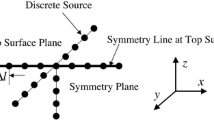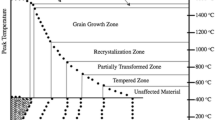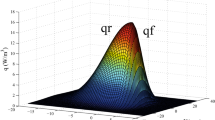Abstract
A general methodology for inverse thermal analysis of steady-state energy deposition in plate structures, typically welds, is extended with respect to its formulation. This methodology is in terms of numerical-analytical basis functions, which provide parametric representations of weld-temperature histories that can be adopted as input data to various types of computational procedures, such as those for prediction of solid-state phase transformations and mechanical response. The extension of the methodology presented here concerns construction of numerical-analytical basis functions and their associated parameterizations, which permit optimal and convenient parameter optimization with respect to different types of weld-workpiece boundary conditions, energy source characteristics, and experimental measurements adoptable as weld-temperature history constraints. Prototype inverse thermal analyses of a steel weld are presented that provide proof of concept for inverse thermal analysis using these basis functions.















Similar content being viewed by others
References
A. Tarantola, Inverse Problem Theory and Methods for Model Parameter Estimation, SIAM, Philadelphia, PA, 2005
C.R. Vogel, Computational Methods for Inverse Problems, SIAM, Philadelphia, PA, 2002
A.G. Ramm, Inverse Problems, Mathematical and Analytical Techniques with Applications to Engineering, Springer Science, New York, 2005
J.V. Beck and K.J. Arnold, Parameter Estimation in Engineering and Science, Wiley Interscience, New York, 1977
J.V. Beck, B. Blackwell, and C.R. St. Clair, Inverse Heat Conduction: IlI-Posed Problems, Wiley Interscience, New York, 1995
O.M. Alifanov and A.P. Tryanin, Determination of the Coefficient of Internal Heat Exchange and the Effective Thermal Conductivity of II, Porous Solid on the Basis of a Nonstationary Experiment, J. Eng. Phys., 1985, 8(3), p 356–365
E.A. Artyukhin, Iterative Algorithms for Estimating Temperature Dependent Thermophysical Characteristics, 1st International Conference on Inverse Problems in Engineering, Proceedings, Palm Coast, FI, 1993, p 101-1011
L. Dantas and H.R.B. Orlande, A Function Estimation Approach for Determining Temperature-Dependent Thermophysical Properties, Inverse Probl. Eng., 1996, 3, p 261–279
T.J. Martin, G.S. Dulikravich, Non-iterative Inverse Determination of Temperature-Dependent Heat Conductivities, HTD-Vol 340 ASME National Heat Transfer Conference, G.S. Dulikravich, K. Woodburry, Ed., Vol 2, 1997, p 141-150
M.M. Mejias, H.R.B. Orlande, and M.N. Ozisik, Design of Optimum Experiments for the Estimation of Thermal Conductivity Components of Orthotropic Solids, Hybrid Methods Eng., 1999, 1, p 37–53
A.J. Silva Neto, M.N. Ozisik, An Inverse Analysis of Simultaneously Estimating Phase Function, Albedo and Optical Thickness, ASME/AIChe Conference, San Diego, CA, August 9-12, 1992
J.C. Bokar and M.N. Ozisik, An Inverse Problem for the Estimation of Radiation Temperature Source Term in a Sphere, Inverse Probl. Eng., 1995, 1, p 191–205
N. Ruperti, Jr., M. Raynaud, and J.F. Sacadura, A Method for the Solution of the Coupled Inverse Heat Conduction-Radiation Problems, ASME J. Heat Transf., 1996, 118, p 10–17
C.H. Huang and M.N. Ozisik, Inverse Problem of Determining Unknown Wall Heat Flux in Laminar Flow Through a Parallel Plate Duct, Numer. Heat Transf. Part A, 1992, 21, p 55–70
H.A. Machado and H.R.B. Orlande, Inverse Analysis of Estimating the Timewise and Spacewise Variation of the Wall Heat Flux in a Parallel Plate Channel, Int. J. Numer. Meth. Heat Fluid Flow, 1997, 7, p 696–710
J.C. Bokar and M.N. Ozisik, An Inverse Analysis for Estimating Time Varying Inlet Temperature in Laminar Flow Inside a Parallel Plate Duct, Int. J. Heat Mass Transf., 1995, 38, p 39–45
H.A. Machado, H.R.B Orlande, Estimation of the Timewise and Spacewise Variation of the Wall Heat Flux to a Non-Newtonian Fluid in a Parallel Plate Channel, International Symposium on Transient Convective Heat Transfer, Proceedings, J. Padet, Ed., Turkey, 1996, p 587-596
H.A. Machado and H.R.B. Orlande, Inverse Problem of Estimating the Heat Flux to a Non-Newtonian Fluid in a Parallel Plate Channel, RBCM J. Braz. Soc. Mech. Sci., 1998, 2, p 51–61
C.H. Huang, M.N. Ozisik, and B. Sawaf, Conjugate Gradient Method for Determining Unknown Contact Conductance During Metal Casting, Int. J. Heat Mass Transf., 1992, 35, p 1779–1789
M.N. Ozisik, H.R.B. OrIande, L.G. Hector, and P.N. Anyalebechi, Inverse Problem of Estimating Interface Conductance During Solidification via Conjugate Gradient Method, J. Mater. Proc. Manuf. Sci., 1992, 1, p 213–225
O.M. Alifanov, Inverse Heat Transfer Problems, Springer, New York, 1994
H.R.B. Orlande and M.N. Ozisik, Determination of the Reaction Function in a Reaction-Diffusion Parabolic Problem, J. Heat Transf., 1994, 116, p 1041–1044
J.S. Brium, D. Delaunay, B. Gamier, and Y. Jamy, Implementation of an Inverse Method for Identification of Reticulation Kinetics from Temperature Measurements on a Thick Sample, Int. J. Heat Mass Transf., 1993, 36, p 4039–4097
C.H. Huang, C.C. Tsai, A Shape Identification Problem in Time Dependent Irregular Boundary Configurations, HTD. Vol 340 ASME National Heat Transfer Conference, G.S. Dulikravich, K. Woodburry, Ed., Vol 2, 1997, p 41-48
C.H. Huang and C.C. Chiang, Shape Identification Problem in Estimating Geometry of Multiple Cavities, AIAA J. Therm. Heat Transf., 1998, 12, p 270–277
G.S. Dulikravich and T.J. Manin, Inverse Shape and Boundary Condition Problems and Optimization in Heat Conduction, Chapter 10 in Advances in Numerical Heat Transfer, Vol 1, W.J. Minkowycz and E.M. Sparrow, Ed., Taylor and Francis, Washington, 1996, p 381–426
N. Zabaras and T.H. Ngugcn, Control of the Freezing Interface Morphology in Solidification Processes in the Presence of Natural Convection, Int. J. Numer. Methods Eng., 1995, 38, p 1555–1578
N. Zabaras and G. Yang, A Functional Optimization Formulation and Implementation of an Inverse Natural Convection Problem, Comput. Methods Appl. Mech. Eng., 1997, 144, p 245–274
G. Yang and N. Zabaras, An Adjoint Method for the Inverse Design of Solidification Processes with Natural Convection, Int. J. Num Meth. Eng., 1998, 42, p 1121–1144
L. Bailleul, D. Delaunay, Y. Jamy, Optimal Thermal Processing of Composite Materials: An Inverse Algorithm and Its Experimental Validation, 11th International Heat Transfer Conference, Vol 5, Kyngju, Korea, 1998, p 87-92
Y. Jamy, D. Delaunay, J.S. Brizaut, Inverse Analysis of the Elastomer Cure Control of the Vulcanization Degree, 1st International Conference on Inverse Problems in Engineering, Proceedings, Palm Coast, FI, 1993, p 291-298
M.N. Ozisik and H.R.B. Orlande, Inverse Heat Transfer, Fundamentals and Applications, Taylor and Francis, New York, 2000
K. Kurpisz and A.J. Nowak, Inverse Thermal Problems, Computational Mechanics Publications, Boston, 1995
O.M. Alifanov, Inverse Heat Transfer Problems, Springer, Berlin, 1994
J.V. Beck, B. Blackwell, and C.R. St. Clair, Inverse Heat Conduction: Ill-Posed Problems, Wiley Interscience, New York, 1985
J.V. Beck, Inverse Problems in Heat Transfer with Application to Solidification and Welding, Modeling of Casting, Welding and Advanced Solidification Processes, V.M. Rappaz, M.R. Ozgu, and K.W. Mahin, Ed., The Minerals, Metals and Materials Society, Warrendale, 1991, p 427–437
J.V. Beck, Inverse Problems in Heat Transfer, Mathematics of Heat Transfer, G.E. Tupholme and A.S. Wood, Ed., Clarendon Press, Oxford, 1998, p 13–24
M.N. Ozisik, Heat Conduction. Chapter 14, Wiley, New York, 1994
M.N. Ozisik, Boundary Value Problems of Heat Conduction, Dover, New York, 1989
O.M. Alifanov, Determination of Heat Loads from a Solution of the Nonlinear Inverse Problem, High Temp., 1977, 15(3), p 498–504
A.N. Tikhonov, Inverse Problems in Heat Conduction, J. Eng. Phys., 1975, 29(1), p 816–820
O.M. Alifanov, Solution of an Inverse Problem of Heat-Conduction by Iterative Methods, J. Eng. Phys., 1974, 26(4), p 471–476
O.M. Alifanov and N.Y. Kerov, Determination of External Thermal Load Parameters by Solving the Two-Dimensional Inverse Heat-Conduction Problem, J. Eng. Phys., 1981, 41(4), p 1049–1053
O.M. Alifanov and V.V. Miklhailov, Solution of the Nonlinear Inverse Thermal Conductivity Problem by the Iteration Method, J. Eng. Phys., 1978, 35(6), p 1501–1506
O.M. Alifanov and V.Y. Mikhailov, Determining Thermal Loads from the Data of Temperature Measurements in a Solid, High Temp., 1983, 21(5), p 724–730
O.M. Alifanov and V.Y. Mikhailov, Solution of the Overdetermined Inverse Problem of Thermal Conductivity Involving Inaccurate Data, High Temp., 1985, 23(1), p 112–117
O.M. Alifanov and A. Rumyantsev, Regularizing Gradient Algorithms for Inverse Thermal-Conduction Problems, J. Eng. Phys., 1980, 39(2), p 858–861
O.M. Alifanov, E. Artyukhin, and A. Rumyantsev, Extreme Methods for Solving Ill-Posed Problems with Applications to Inverse Heat Transfer Problems, Begell House, New York, 1995
D.A. Murio, The Modification Method and the Numerical Solution of an Inverse Heat Conduction Problem, SIAM J. Sci. Stat. Comput., 1981, 2, p 17–34
E.M. Sparrow, A. Haji-Sheikh, and T.S. Lundgren, The Inverse Problem in Transient Heat Conduction, J. Appl. Mech., 1964, 86E, p 369–375
M. Imber and J. Khan, Prediction of Transient Temperature Distributions with Embedded Thermocouples, AIAA J., 1972, 10, p 784–789
M. Imber, Two-Dimensional Inverse Conduction Problem, Further Observations, AIAA J., 1975, 13, p 114–115
K.C. Woo and L.C. Chow, Inverse Heat Conduction by Direct Inverse Laplace Transform, Numer. Heat Transf., 1981, 4, p 499–504
C.F. Weber, Analysis and Solution of the Ill-Posed Inverse Heat Conduction Problem, Int. J. Heat Mass Transf., 1981, 24, p 1783–1792
J.V. Beck, Nonlinear Estimation Applied to the Nonlinear Inverse Heat Conduction Problem, Int. J. Heat Mass Transf., 1970, 13, p 703–716
N. D’Souza, Numerical Solution of One-Dimensional Inverse Transient Heat Conduction by Finite Difference Method, ASME Paper No. 75WAlHT-81, 1975
L. Garifo, V.E. Schrock, and E. Spedicato, On the Solution of the Inverse Heat Conduction Problem by Finite Differences, Energia Nucl., 1975, 22, p 452–464
B.R. Bass and L.J. Ott, A Finite Element Formulation of the Two-Dimensional Nonlinear Inverse Heat Conduction Problem, Adv. Comput. Technol., 1980, 2, p 238–248
D.A. Murio, The Mollification Method and the Numerical Solution of the Inverse Heat Conduction Problem by Finite Difference, Comput. Math Appl., 1896, 17(1385), p 1989
Y. Jarny, M.N. Ozisik, and J.P. Bardon, A General Optimization Method Using Adjoint Equation for Solving Multidimensional inverse Heat Conduction, Int. J. Heat Mass Transf., 1991, 34, p 2911–2929
H.Y. Li and M.N. Ozisik, Identification of the Temperature Profile in an Absorbing, Emitting, and Isotropically Scattering Medium by Inverse Analysis, J. Heat Transf., 1992, 114, p 1060–1063
C.H. Ho and M.N. Ozisik, An Inverse Radiation Problem, Int. J. Heat Mass Transf., 1989, 32, p 335–341
B.G. Abnlmovich and V.S. Trofunov, Integral Form of the Inverse Heat Conduction Problem for a Hollow Cylinder, High Temp. (USSR), 1979, 17, p 552–554
C.H. Ho and M.N. Ozisik, Inverse Radiation Problem in Inhomogeneous Media, J Quant. Spectrosc. Radiat. Transf., 1988, 40, p 553–560
H.R.B. Orlande, M.N. Ozisik, Inverse Problems Computations in Heat and Mass Transfer, International Conf. on Comput. Heat and Mass Transfer, Keynote lecture, North Cyprus, April, 1999
E.A. Artyukhin and A.V. Nenarokomov, Coefficient Inverse Heat Conduction Problem, J. Eng. Phys., 1988, 53, p 1085–1090
O.M. Alifanov and M.Y. Klibanov, Uniqueness Conditions and Method of Solution of the Coefficient Inverse Problem of Thermal Conductivity, J. Eng. Phys., 1985, 48(6), p 730–735
E.A. Artyukhin, Reconstruction of the Thermal Conductivity Coefficient from the Solution of the Nonlinear Inverse Problem, J. Eng. Phys., 1981, 41(4), p 1054–1058
J.V. Beck, Calculation of Surface Heat Flux from an Internal Temperature History, ASME Paper 61-HT-46, 1962
J.V. Beck, Surface Heat Flux Determination Using an Integral Method, Nucl. Eng. Des., 1968, 7, p 170–178
A.M. Osman, K.J. Dowding, and J.V. Beck, Numerical Solution of the General Two-dimensional Inverse Heat Conduction Problem, ASME J. Heat Transf., 1997, 119, p 38–44
C.J. Chen, D.M. Thomsen, On Determination of Transient Surface Temperature and Heat Flux by Imbedded Thermocouple in a Hollow Cylinder, Tech. Rept., Rock Island Arsenal, Rock Island, IU, March 1974
H.Y. Li and M.N. Ozisik, Inverse Radiation Problem for Simultaneous Estimation of Temperature Profile and Surface Reflectivity, J. Thermophys. Heat Transf., 1993, 7, p 88–93
H.Y. Li and M.N. Ozisik, Estimation of the Radiation Source Term with a Conjugate-Gradient Method of Inverse Analysis, J. Quant. Spectrosc. Radiat. Transf., 1992, 48, p 237–244
H.R.B. Orlande and M.N. Ozisik, Inverse Problem of Estimating Interface Conductance Between Periodically Conducting Surfaces, J. Thermophys. Heat Transf., 1993, 7, p 319–325
J.V. Beck, Criteria for Comparison of Methods of Solution of the Inverse Heat Conduction Problems, Nucl. Eng. Des., 1979, 53, p 11–22
D. Lesnic, I. Elliot, and O.B. Ingham, Application of the Boundary Element Method to Inverse Heat Conduction Problems, Int. J. Heat Mass Transf., 1996, 39, p 1503–1517
T.J. Martin and G.S. Dulikravich, Inverse Determination of Steady Convective Local Heat Transfer Coefficients, ASME J. Heat Transf., 1998, 120, p 328–334
T.J. Martin and G.S. Dulikravich, Inverse Determination of Boundary Conditions in Steady Heat Conduction with Heat Generation, ASME J. Heat Transf., 1996, 118, p 546–554
C.H. Huang and M.N. Ozisik, Optimal Regularization Method to Determine the Strength of a Plane Surface Heat Source, Int. J. Heat Fluid Flow, 1991, 12, p 173–178
S.G. Lambrakos and S.G. Michopoulos, Algorithms for Inverse Analysis of Heat Deposition Processes, Mathematical Modelling of Weld Phenomena, Vol 8, Verlag der Technischen Universite Graz, Graz, 2007, p 847
S.G. Lambrakos and J.O. Milewski, Analysis of Welding and Heat Deposition Processes using an Inverse-Problem Approach, Mathematical Modelling of Weld Phenomena, Vol 7, Verlag der Technischen Universite Graz, Graz, 2005, p 1025–1055
E.A. Metzbower, D.W. Moon, C.R. Feng, S.G. Lambrakos, and R.J. Wong, Modelling of HSLA-65 GMAW Welds, Mathematical Modelling of Weld Phenomena, Vol 7, Verlag der Technischen Universite Graz, Graz, 2005, p 327–339
S.G. Lambrakos, Inverse Thermal Analysis of 304L Stainless Steel Laser Welds, J. Mater. Eng. Perform., 2013, 22(8), p 2141
S.G. Lambrakos, Inverse Thermal Analysis of Stainless Steel Deep-Penetration Welds Using Volumetric Constraints, J. Mater. Eng. Perform., 2014, 23(6), p 2219–2232. doi:10.1007/s11665-014-1023-7
S.G. Lambrakos, Inverse Thermal Analysis of Welds Using Multiple Constraints and Relaxed Parameter Optimization, J. Mater. Eng. Perform., August 2015, 24(8), p 2925–2936
S.G. Lambrakos, A. Shabaev, and L. Huang, Inverse Thermal Analysis of Titanium GTA Welds Using Multiple Constraints, J. Mater. Eng. Perform., 2015, 24(6), p 2401–2411. doi:10.1007/s11665-015-1511-4
S.G. Lambrakos, A. Shabaev, Temperature Histories of Ti-6Al-4 V Pulsed-Mode Laser Welds Calculated Using Multiple Constraints, Naval Research Laboratory Memorandum Report, Naval Research Laboratory, Washington, DC, NRL/MR/6390-15-9621, August 12, 2015
E.W. Reutzel, S.M. Kelly, R.P. Martukanitz, M.M. Bugarewicz, P. Michaleris, Laser-GMA Hybrid Welding: Process Monitoring and Thermal Modeling, Trends in Welding Research, Proceedings of the 7th International Conference, S.A. David, T. DebRoy, J.C. Lippold, H.B. Smartt, J.M. Vitek, Eds., ASM International, 2006, p 143-148
J.G. Michopoulos, S.G. Lambrakos, On the Fundamental Tautology of Validating Data-Driven Models and Simulations, Simulation of Multiphysics Multiscale Systems, International Conference on Computational Science, Vol 2, 2005, p 738-745
D. Rosenthal, The Theory of Moving Sources of Heat and Its Application to Metal Treatments, Trans ASME, 1946, 68, p 849–866
J. Goldak, A. Chakravarti, and M. Bibby, A New Finite Element Model for Welding Heat Source, Metall. Trans. B, 1984, 15, p 299–305
O. Grong, Materials Modelling Series, Metallurgical Modelling of Welding, Chapter 2, 2nd ed., H.K.D.H. Bhadeshia, Ed., The Institute of Materials, London, 1997, p 1–115
R.O. Myhr and O. Grong, Dimensionless Maps for Heat Flow Analyses in Fusion Welding, Acta Metall. Mater., 1990, 38, p 449–460
R.C. Reed and H.K.D.H. Bhadeshia, A Simple Model For Multipass Welds, Acta Metall. Mater., 1994, 42(11), p 3663–3678
V.A. Karkhin, P.N. Homich, and V.G. Michailov, Models for Volume Heat Sources and Functional-Analytic Technique for Calculating the Temperature Fields in Butt Welding, Mathematical Modelling of Weld Phenomena, Vol 8, Verlag der Technischen Universite Graz, Graz, 2007, p 847
A.A. Deshpande, A. Short, W. Sun, D.G. McCartney, L. Xu, and T.H. Hyde, Finite-Element Analysis of Experimentally Identified Parametric Envelopes for Stable Kethole Plasma Arc Welding of a Titanium Alloy, J. Strain Anal. Eng. Des., 2012, 47(5), p 266–275
I.S. Leoveanu, G. Zgura, and D. Birsan, Modeling the Heat and Fluid Flow in the Welded Pool, Bull. Transsilv. Univ. Brasov, 2007, 3, p 363–368 (ISSN 1223-9631)
I.S. Leoveanu and G. Zgura, Modelling the Heat and Fluid Flow in the Welded Pool from High Power Arc Sources, Materials Science Forum, Vol 580-582, C. Lee, J.-B. Lee, D.-H. Park, and S.-J. Na, Ed., Trans Tech Publications, Dürnten, 2008, p 443–446
R.W. Farebrother, Linear-Least-Square Computations, Marcel Dekker, New York, 1988
Y.B. Bard, Nonlinear Parameter Estimation, Academic Press, New York, 1974
S.W. Smith, The Scientist and Engineer’s Guide to Digital Signal Processing, California Technical Publishing, San Diego, CA, 1997
H.S. Carslaw and J.C. Jaegar, Conduction of Heat in Solids, 2nd ed., Clarendon Press, Oxford, 1959, p 374
S.V. Patankar, Numerical Heat Transfer and Fluid Flow, Series in Computational Methods in Mechanics and Thermal Sciences, Hemisphere Publishing Corporation, London, 1980
W.H. Press, S.A. Teukolsky, W.T. Vetterling, and B.P. Flannery, Numerical Recipes in Fortran 77, The Art of Scientific Computing, Vol 1, 2nd ed., Fortran Numerical Recipes Cambridge University Press, New York, 1997
S. Kou, Welding Metallurgy, 2nd ed., Wiley, Hoboken, 2003, doi:10.1002/0471434027
B. Smith, P. Bjorstad, and W. Gropp, Domain Decomposition, Parallel Multilevel Methods for Elliptic Partial Differential Equations, Cambridge University Press, Cambridge, 2004
A. Quarteroni and A. Valli, Domain Decomposition Methods for Partial Differential Equations, Numerical Mathematics and Scientific Computation, Oxford University Press, Oxford, 1999
A. Toselli and O. Widlund, Domain Decomposition Methods-Algorithms and Theory, Springer Series in Computational Mathematics Springer, New York, 2005
Acknowledgment
This work was supported by a Naval Research Laboratory (NRL) internal core program.
Author information
Authors and Affiliations
Corresponding author
Appendix
Appendix
- T :
-
Temperature of workpiece
- T A :
-
Ambient temperature of workpiece
- \(T_{n}^{c}\) :
-
Constraint condition on temperature field
- T M :
-
Melting temperature
- T HE :
-
Temperature of HAZ-edge as measured (using thermocouples)
- κ:
-
Thermal diffusivity
- V :
-
Welding speed
- l 1 :
-
Thickness of workpiece
- l 2 :
-
Transverse-length parameter or tranverse length of workpiece
- l 3 :
-
Longitudinal-length parameter or longitudinal length of workpiece
- \(C\left( {\hat{x}_{k} } \right)\) :
-
Volumetric source function
- Δt :
-
Time step for specifying average energy deposited during the time Δt
- l S :
-
Length parameter specifying local region of temperature field to be calculated
- Δl :
-
Spatial discretization of the temperature field with respect to l S
- Z T :
-
Value of objective function
Rights and permissions
About this article
Cite this article
Lambrakos, S.G. Parametric Modeling of Welding Processes Using Numerical-Analytical Basis Functions and Equivalent Source Distributions. J. of Materi Eng and Perform 25, 1360–1375 (2016). https://doi.org/10.1007/s11665-016-1970-2
Received:
Revised:
Published:
Issue Date:
DOI: https://doi.org/10.1007/s11665-016-1970-2




